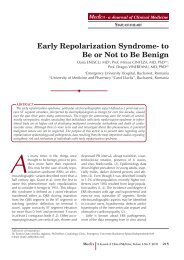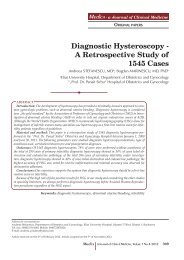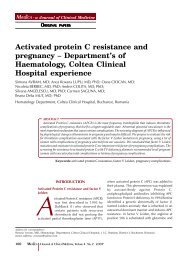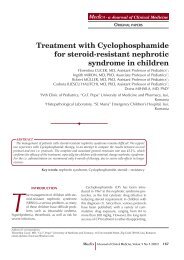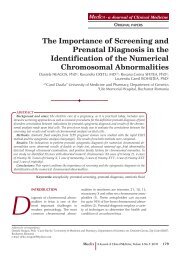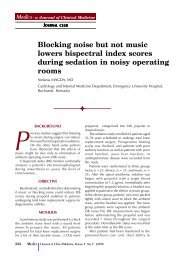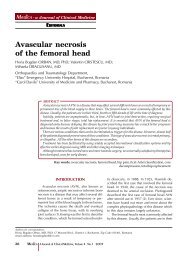Hypereosinophilic Syndromes â Recent Advances In Definition
Hypereosinophilic Syndromes â Recent Advances In Definition
Hypereosinophilic Syndromes â Recent Advances In Definition
Create successful ePaper yourself
Turn your PDF publications into a flip-book with our unique Google optimized e-Paper software.
M K pag 149M K pag 149HYPEREOSINOPHILIC SYNDROMES – RECENT ADVANCES IN DEFINITION, CLASSIFICATION AND THERAPEUTIC APPROACH– Lymphocytic-HES (L-HES): patients withchronic reactive eosinophilia in responseto IL-5 over-production by T cells.– Myeloproliferative-HES (M-HES): patientswith a large array of clinical and biologicalfeatures (elevated levels of vitaminB12, hepatomegaly, splenomegaly, anemia,thrombocytopenia, circulating myeloid,displastic eosinophils, bone marrowhypercellularity with increased numberof myeloid precursors, myelofibrosis,increased serum tryptase and responseto imatinib), suggesting an underlyingmyeloproliferative disorder associatedwith eosinophilia but having no evidenceof molecular defects.– Idiopathic hypereosinophilic syndrome(HES): patients with eosinophilia of unknowncause.– Organ-restricted eosinophilic disease:only one specific tissue or organ involvement(e.g. eosinophilic esophagitis, eosinophilicgastroenteritis, eosinophilic pneumonia,Kimura disease, eosinophilic dermatitis,eosinophilic fasciitis)Although this rather complicated classificationraised multiple debates regarding its accuracy,it proved to be useful for defining certainpathogenic entities (11).Lately, new molecular data improved thediagnosis guidelines of the eosinophilic disordersand an entirely new classification emerged(WHO classification of tumors ofhaematopoietic and lymphoid tissues 2008).The following entitis are now acknowledged(12):Chronic eosinophilic leukemia (CEL) definedas a clonal proliferation of eosinophilicprecursors, accumulation of eosinophils in peripheralblood and bone marrow, causing endorgan damage due to the tissue eosinophilicinfiltration and release of eosinophilic proteins.Patients expressing Philadelphia chromosome,BCR-ABL1, PDGFRA, PDGFRB and FGFR1 fusiongenes are excluded.Diagnosis criteria:– AEC>1.5 x 10 9 /L in peripheral blood orbone marrow eosinophilia– exclusion of reactive causes of eosinophiliaincluding hematological malignancies(e.g. aCML, CML, CMML andlymphoproliferative disorders)– exclusion of a T-cell abnormal populationthat produces increased eosinophilopoieticcytokines– peripheral blood blasts >2% and bonemarrow blasts 5% – 20%or– evidence of eosinophil clonalityIf the clonality of the eosinophils cannot bedemonstrated and bone marrow blasts are lessthan 5%, the term “Idiopathic HES” must beused.Idiopathic HES: is a diagnosis of exclusion.<strong>In</strong> time, some of these patients initially diagnosedas Idiopathic HES may develop clinicalfeatures resembling CEL or hypereosinophiliainduces by cytokines (IL-2, IL-3, IL-5).Diagnosis criteria:– persistent eosinophilia (AEC >1,5 x 10 9 /L) for more than 6 months– exclusion of reactive causes of eosinophilia– exclusion AML, MPD, MDS, MPD/MDSand SM– exclusion of a T-cell abnormal populationwith increased production of eosinophilopoieticcytokines– end organ damage– no the evidence of eosinophilic clonality(exclusion of Philadelphia chromosome,BCR-ABL1, PDGFRA, PDGFRB andFGFR1 fusion genes, myeloproliferativedisorders as PV, ET, IMF or MPD/MDSare excluded).Idiopathic hypereosinophilia includes allthese criteria except for end organ damage.Myeloid neoplasms (MPN) with eosinophiliaand PDGFRA, PDGFRB and FGFR1 rearrangements:three distinct entities with cytogeneticabnormalities resulting in fusion geneswith tyrosine-kinase activity; some of them areimatinib sensitive. The hematological featuresare those of myeloid or lymphoid neoplasms.PDGFRA rearrangement: usually presentsas CEL +/- mastocitosis and less often as AMLor lymphoblastic lymphoma with eosinophilia.These patients present clinical features of achronic disease with constitutional symptoms(weakness, weight loss, night sweats, pruritus)and virtually any organ may be involved: heart,lungs (restrictive dysfunction with fibrosis), gastrointestinaltract, skin, spleen, rarely liver. Somepatients progress to acute forms. Prognosis dependsmainly on the cardiac involvement(endomyocardial fibrosis with restrictive cardi-Mædica A Journal of Clinical Medicine, Volume 4 No.2 2009 149






